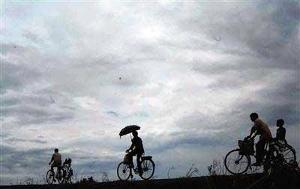March 11, 2014
HYDERABAD: India's states will see more intense unpredictable freak weather in the coming days, warned climate change scientists, days after huge chunks of hail killed at least 10 people and wounded scores in Andhra Pradesh and hail storms this week destroyed cropland across Karnataka and Maharashtra.

March 11, 2014
HYDERABAD: India's states will see more intense unpredictable freak weather in the coming days, warned climate change scientists, days after huge chunks of hail killed at least 10 people and wounded scores in Andhra Pradesh and hail storms this week destroyed cropland across Karnataka and Maharashtra.

Scientists predict extreme weather conditions
"The key word is these extreme events will increase under climate change and we near to gear up quickly to counter it before it's too late though micro-level climate vulnerability assessment and drastic cut on fossil fuel emission," G Bala, a top climate change expert at the Indian Institute of Science's Divecha Centre for Climate Change in Bangalore.
In absence of quality assessment, met department officials are struggling to answer why places like Hyderabad gets heavy rainfall in early March and sudden hail storms destroys lakhs of acres of land in Warangal, Bidar in Karnataka or Nasik and Aurangabad in Maharashtra this week.
Scientists have predicted that the frequency of extreme weather is likely to increase with less rainy days, but more quantum of rainfall because of more intensity and severe drought hitting other places.
They say states should immediately carry out a micro-level study to assess the unpredictable weather as the country's fossil fuel emission is going up at alarming levels with no effort being made by governments to address climate change at local levels.
"Knowledge is very important and information about climate change must be provided to politicians and policy makers. But there is simply no information. Climate action plans for states lack quality and there is no solid quality which is based on science," said Bala.
Scientists say last June's cloudburst in Uttarakhand, a severe cold wave in north India this year, heavy snowfall in Chevalla, a sleepy hamlet in Andhra Pradesh last January, and Bangalore city recording 32 degree Celsius in January this year, are all extreme local weather phenomena, which needs to be studied and analyzed carefully.
"What needs to happen is a clear micro-level vulnerability assessment that can help us understand and prepare for these unusual weather that will only increase," says Siddharth Pathak, an International policy coordinator at the Climate Action Network International.
India in 2009 said it will reduce its emission intensity by 25 percent, and agreed with other developed countries to keep global warming at a check and stop rate of growth of temperature at 2 degrees.
But an international study led by United Kingdom's Tyndall Centre for Climate Change Research released in November last year revealed India was among the biggest contributors to fossil fuel emissions in 2012 with CO2 emissions rising by a whopping 7.7 percent, mostly from burning coal. Local scientists now calculate India's fossil fuel emission at 60 percent more than what it was 20 years ago, with the country all set to breach the 2 degree temperature rise mark.
"Some of the extreme rise in temperature is going to rise with higher intensity across the country unless steps are taken to reduce emission drastically," said Raman Sukumar, an ecological scientist at Indian Institute of Sciences.
Back in Hyderabad, RV Subba Rao, a retired meteorologist, who is busy studying the weather charts says the wind pattern has been different this March and predicts early monsoon.
"Climate change is occurring due to development of El Nino in the Pacific Ocean and some freaky weather condition as a result will continue till May this year," he said.
"We need to do more research on climate vulnerability as this early March weather has been something very new, which I have not seen here before," he added.
Courtesy: TNN















































































































